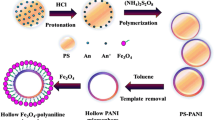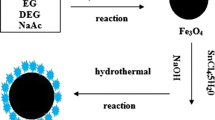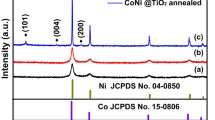Abstract
Uniform core-shell SiO2@Fe3O4@C microspheres were prepared by a one-step hydrothermal method with SiO2 microspheres as the template, and the hollow Fe3O4@C (HFC) microspheres were achieved via etching SiO2 template. By changing the sizes of SiO2 microspheres, a series of HFC microspheres with variable cavity sizes were obtained to study the relationship between cavity size and microwave absorbing (MA) performance for the first time. The morphology and structure of samples were characterized in detail. The results showed that the MA performance of HFC sample depended on its cavity size. In particular, the hollow structure was good for improving MA performance and could make MA move to the high-frequency region. More importantly, as the cavity size increases, the resonance frequency of HFC-i (i=1, 2, 3, 4) samples moved to a low frequency, and the optimal matching thickness of HFC-i samples was increasing. Among all HFC-i samples, HFC-3 showed the most excellent MA performance, which could be mainly explained by the quarter-wavelength matching model, intrinsical magnetic and dielectric loss. Furthermore, the MA performance of HFC mixture blended by the equal mass fraction of HFC-2, HFC-3 and HFC-4 was the comprehensive results of three HFC-i samples. All the above suggested that the cavity size in HFC sample had a great influence on the MA performance.
Similar content being viewed by others
References
Lv Y, Yu L, Li C, Yang L. Sci China Chem, 2016, 59: 142–149
Liu Z, Lu G, Yin H, Dang Z, Rittmann B. Environ Sci Technol, 2015, 49: 5288–5300
Zeng Z, Jin H, Chen M, Li W, Zhou L, Zhang Z. Adv Funct Mater, 2016, 26: 303–310
Kar GP, Biswas S, Rohini R, Bose S. J Mater Chem A, 2015, 3: 7974–7985
Liu JW, Xu JJ, Liu ZW, Liu XL, Che RC. Sci China Chem, 2014, 57: 3–12
Fang J, Liu T, Chen Z, Wang Y, Wei W, Yue X, Jiang Z. Nanoscale, 2016, 8: 8899–8909
Zhao B, Shao G, Fan B, Wang C, Xie Y, Zhang R. Powder Technol, 2015, 270: 20–26
Zhu W, Wang L, Zhao R, Ren J, Lu G, Wang Y. Nanoscale, 2011, 3: 2862–2864
Sözeri H, Mehmedi Z, Kavas H, Baykal A. Ceram Int, 2015, 41: 9602–9609
Zeng M, Liu J, Yue M, Yang HZ, Dong HR, Tang WK, Jiang H, Liu XF, Yu RH. J Appl Phys, 2015, 117: 17B527
Shen JH, Chen KY, Li LC, Ding Y, Li JB, Kong WQ. Sci China Tech Sci, 2014, 57: 1858–1864
Venkatachalam S, Bertin D, Ducournau G, Lampin JF, Hourlier D. Carbon, 2016, 100: 158–164
Lee SE, Lee WJ, Oh KS, Kim CG. Carbon, 2016, 107: 564–572
Chen Y, Zhang W, Yang S, Hobiny A, Alsaedi A, Wang X. Sci China Chem, 2016, 59: 412–419
Shen J, Chen K, Li L, Wang W, Jin Y. J Alloy Compd, 2014, 615: 488–495
Yu L, Liu Y, Yang F, Evans J, Rodriguez JA, Liu P. J Phys Chem C, 2015, 119: 16614–16622
Shen J, Feng J, Li L, Tong G, He Y. J Alloy Compd, 2015, 632: 490–499
Yuan K, Che R, Cao Q, Sun Z, Yue Q, Deng Y. ACS Appl Mater Interfaces, 2015, 7: 5312–5319
Zhao B, Shao G, Fan B, Zhao W, Xie Y, Zhang R. J Mater Chem A, 2015, 3: 10345–10352
Li Y, Wu T, Jiang K, Tong G, Jin K, Qian N, Zhao L, Lv T. J Mater Chem C, 2016, 4: 7119–7129
Panigrahi R, Srivastava SK. Sci Rep, 2015, 5: 7638
Lv H, Ji G, Liu W, Zhang H, Du Y. J Mater Chem C, 2015, 3: 10232–10241
Han M, Yin X, Kong L, Li M, Duan W, Zhang L, Cheng L. J Mater Chem A, 2014, 2: 16403–16409
Zhang Y, Huang Y, Zhang T, Chang H, Xiao P, Chen H, Huang Z, Chen Y. Adv Mater, 2015, 27: 2049–2053
Moyer JA, Gao R, Schiffer P, Martin LW. Sci Rep, 2015, 5: 10363
Sun X, He J, Li G, Tang J, Wang T, Guo Y, Xue H. J Mater Chem C, 2013, 1: 765–777
Shen J, Ma G, Zhang J, Quan W, Li L. Appl Surface Sci, 2015, 359: 455–468
Sato T, Iijima T, Seki M, Inagaki N. J Magn Magn Mater, 1987, 65: 252–256
Wen F, Zhang F, Liu Z. J Phys Chem C, 2011, 115: 14025–14030
Hsiao YC, Wu T, Zang H, Li M, Hu B. Sci China Chem, 2015, 58: 239–247
Huang Y, Wang Y, Li Z, Yang Z, Shen C, He C. J Phys Chem C, 2014, 118: 26027–26032
Jazirehpour M, Seyyed Ebrahimi SA. J Alloy Compd, 2015, 639: 280–288
Zhao B, Zhao W, Shao G, Fan B, Zhang R. ACS Appl Mater Interfaces, 2015, 7: 12951–12960
Acknowledgments
This work was supported by the National Natural Science Foundation of China (20104017), and the College Students’ Science and Technology Innovation Activities Plan of Zhejiang (2014R404056).
Author information
Authors and Affiliations
Corresponding author
Electronic supplementary material
Rights and permissions
About this article
Cite this article
Hou, Y., Yuan, H., Chen, H. et al. Controlled fabrication and microwave absorbing mechanism of hollow Fe3O4@C microspheres. Sci. China Chem. 60, 740–747 (2017). https://doi.org/10.1007/s11426-016-9001-5
Received:
Accepted:
Published:
Issue Date:
DOI: https://doi.org/10.1007/s11426-016-9001-5




